So, you’re looking for a product management software solution. Just 15 years ago, this would’ve been a far more difficult task, because software tools made specifically for product teams didn’t exist. You would’ve had to do what product departments around the world did: find a software solution designed for something else (accounting, task management, etc.) and brute-force it into a place to capture and view your product data.
In that sense, you’re fortunate to be working as a product professional today — because purpose-built product management apps are everywhere.
But that creates another challenge. Today, there are many product management software platforms to choose from. And many more apps (including airfocus, as we’ll demonstrate below) claim to be made for product management but are actually better suited to project management. With all of these solutions competing to become your product team’s software platform, how do you know which one is right for your company?
This guide is here to help you cut through the noise and learn what each of the major product tools actually does. And more specifically, we’ll help you review the best alternatives to airfocus.
What Is a Product Management Solution?
Product management software should create a central environment to conceptualize, plan, prioritize, and manage your product’s lifecycle at the strategic level. That means you’ll want to find a solution that creates a unified digital hub for your team to:
- Manage your product backlog.
- Prioritize the initiatives that promise the most strategic advantage for your company.
- Define and update personas, user stories, and other key elements of your strategy.
- Build your product roadmap and present as much or as little detail as needed.
- Capture and analyze user feedback and tie those notes to relevant features.
- Monitor your capacity levels so you can adjust resource allocation accordingly.
- Monitor your company’s product plans and resources at the portfolio level.
- Integrate your product management data with your dev tools, such as Jira.
That’s a lot to ask of a single software platform. And as you’ll see below, most of the solutions on the market today — including airfocus — fall short of delivering this all-in-one product management environment.
What to Check When Comparing airfocus Alternatives
When you’re investigating these tools, you’ll want to focus your attention on the specific product-management functionality each software solution offers.
Many apps claiming to be built for Product Managers are great for task tracking and project management, but those are tactical workflows. You’re looking for a tool designed to create an intuitive and flexible experience for the strategic workflows — prioritizing, planning, roadmapping — that characterize Product Managers’ work.
The Problem with airfocus
On both Software Advice and Capterra (as well as the eLearning Industry website), airfocus describes itself as software for project management. airfocus’s self-description on Capterra, for example, begins with this sentence:
“airfocus offers a modern and modular project management platform.”
This is an important point, because project management and product management are different roles and have different areas of responsibility when it comes to developing and managing successful products.
Product management sets the strategy (through persona definitions, backlog prioritization, roadmapping, etc.) and hands off that strategy to a project management team, which breaks the strategic plans and goals into actionable tasks that the team can assign and track.
airfocus does seem to be a better fit as project management software than a platform designed for product management. For example, one of the product’s flagship features is task management — a tactical workflow, and an important one, but not something Product Managers should be focused on in their primary product management workspace.
But airfocus is significantly lacking in many of the most important strategic areas of a true product management solution. For example, the platform:
- Lacks customization for roadmap views and presentation (a must-have for product teams that need to share strategic roadmaps with different stakeholders).
- Offers very limited prioritization capabilities.
- Does not offer built-in capacity planning.
- Lacks the ability to set and manage personas, establish OKRs, and connect these strategic elements to products or specific functionality.
Note: Take one more look at how airfocus describes itself: “A modern and modular project management platform.” What does modern mean, exactly? Doesn’t tell you much, does it? And what about modular? That term means only that you can use some portions of the airfocus solution and ignore others — just as you can do with every piece of software you’ve ever used in your life.
If these are the two terms the company chooses to highlight what’s best about the solution, that should tell you a lot about the shortcomings of airfocus. And remember, the next three words in that same description — “project management platform” — tell you a lot about how specific the application is for Product Managers’ most important workflows.
Now let’s see how airfocus measures up against its competitors.
craft.io vs. airfocus
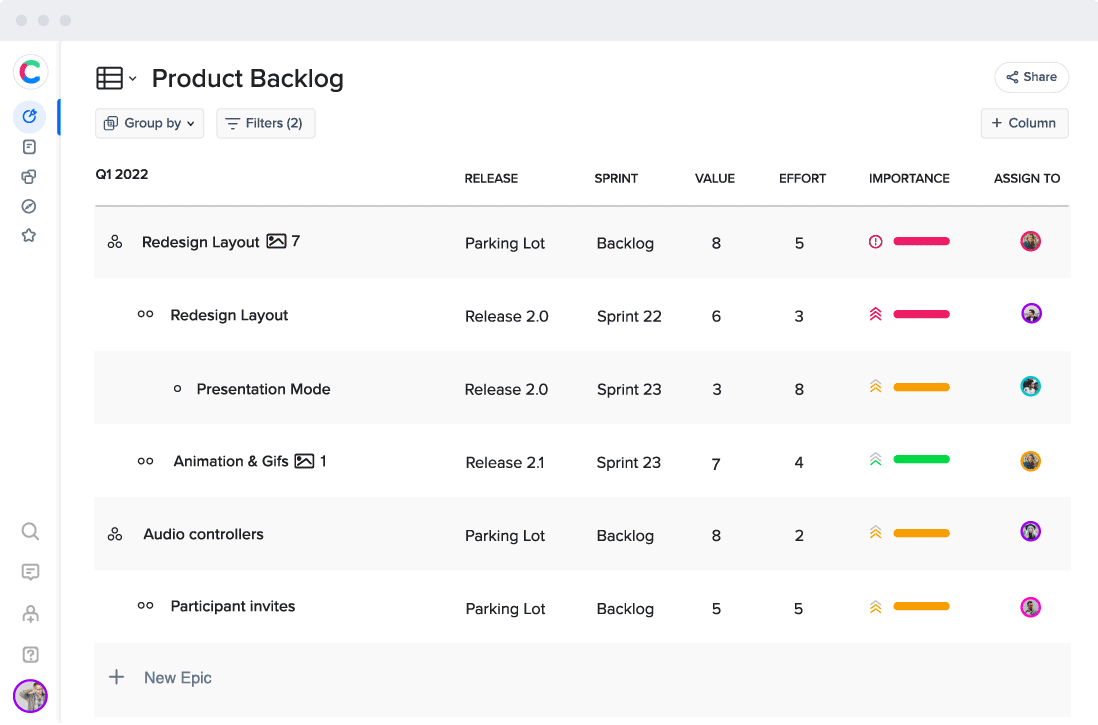
What is craft.io?
craft.io is what airfocus claims to be (but isn’t) — an end-to-end product management platform designed by Product Managers, for Product Managers.
craft.io pros:
- Complete product management environment in a single pane of glass — centralizing roadmapping, prioritization, capacity planning, dependency management, etc.
- An intuitive data model: 4-item data hierarchy that aligns seamlessly with Jira.
- Ease of use: craft.io’s UX/UI is super clear and friendly
- The Guru layer: A collection of best-practice templates to help Product Managers effortlessly apply proven best practices such as roadmap templates, prioritization frameworks, and strategic models, with just a click of a button.
- Excel-like UX: Excel-like table functionality to view, sort, and edit items properties directly in tables, create prioritization and apply capacity planning
- Infinite flexibility for viewing and presentation — from Kanban to swimlane to timeline in a few clicks.
- Seamless integrations with dev tools (Jira, Azure DevOps), visual collaboration apps (Miro, Axure), and design software (Figma, Adobe XD).
craft.io cons:
- We’re still researching this, but so far, we’ve come up with nothing.
Productboard vs. airfocus
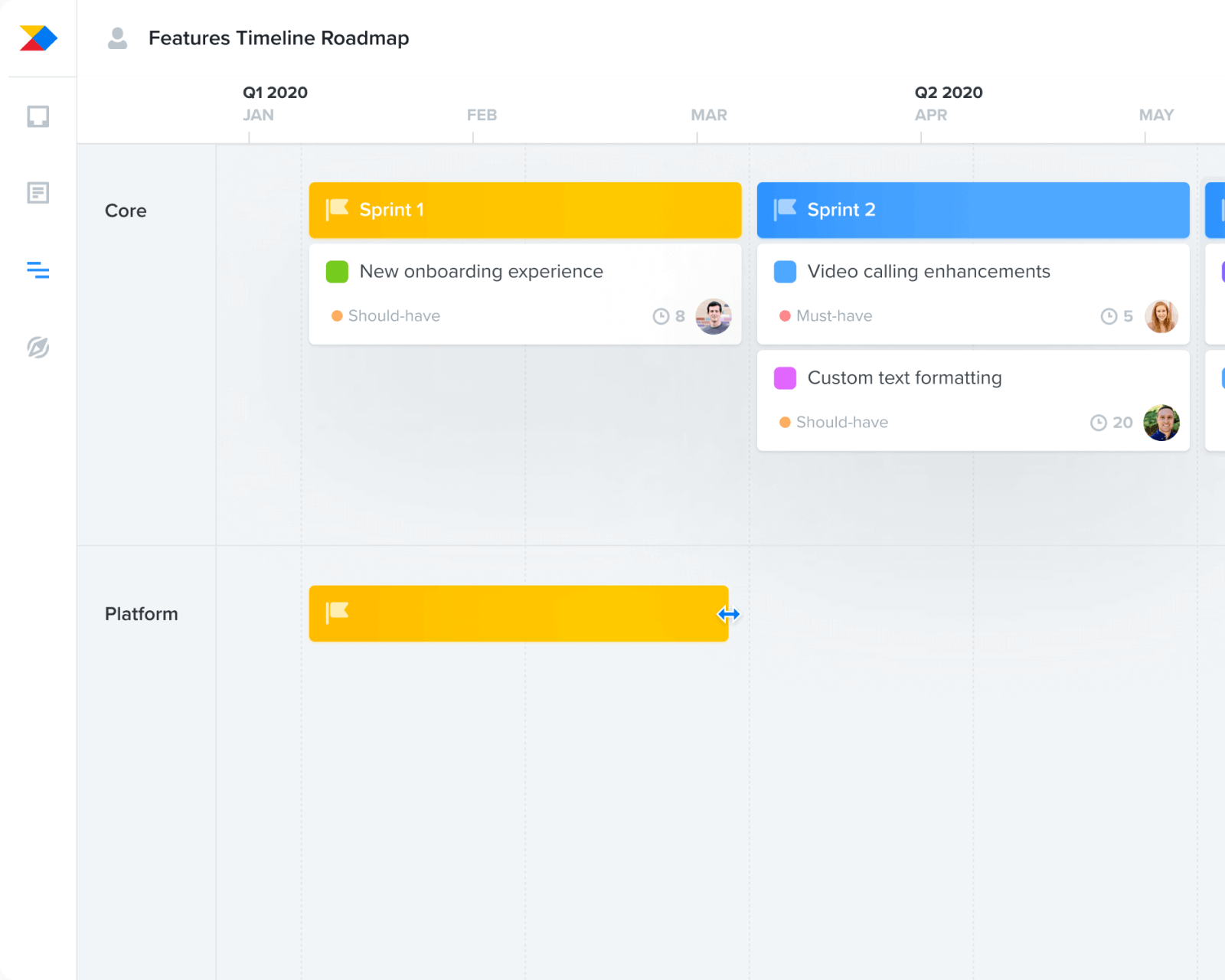
What is Productboard?
Productboard is a purpose-built software tool for Product Managers, so it has that narrow advantage over airfocus. But in terms of strategic functionality for product teams, you won’t find much here.
In fact, it’s worth pointing out that this platform is weak on (or lacks completely) several of the key product management workflows your team will need on a regular basis. It might actually make more sense to think of Productboard as a point solution — specifically, a tool for roadmapping and customer feedback — than an end-to-end product management platform.
Productboard pros:
- Designed for Product Managers and their teams.
- Offers strong roadmapping and feedback collection functionality.
- Integrates with Jira.
Productboard cons:
- Lacks built-in best practice frameworks and templates.
- Does not include capacity planning functionality.
- Does not offer flexible data views.
Aha! vs. airfocus
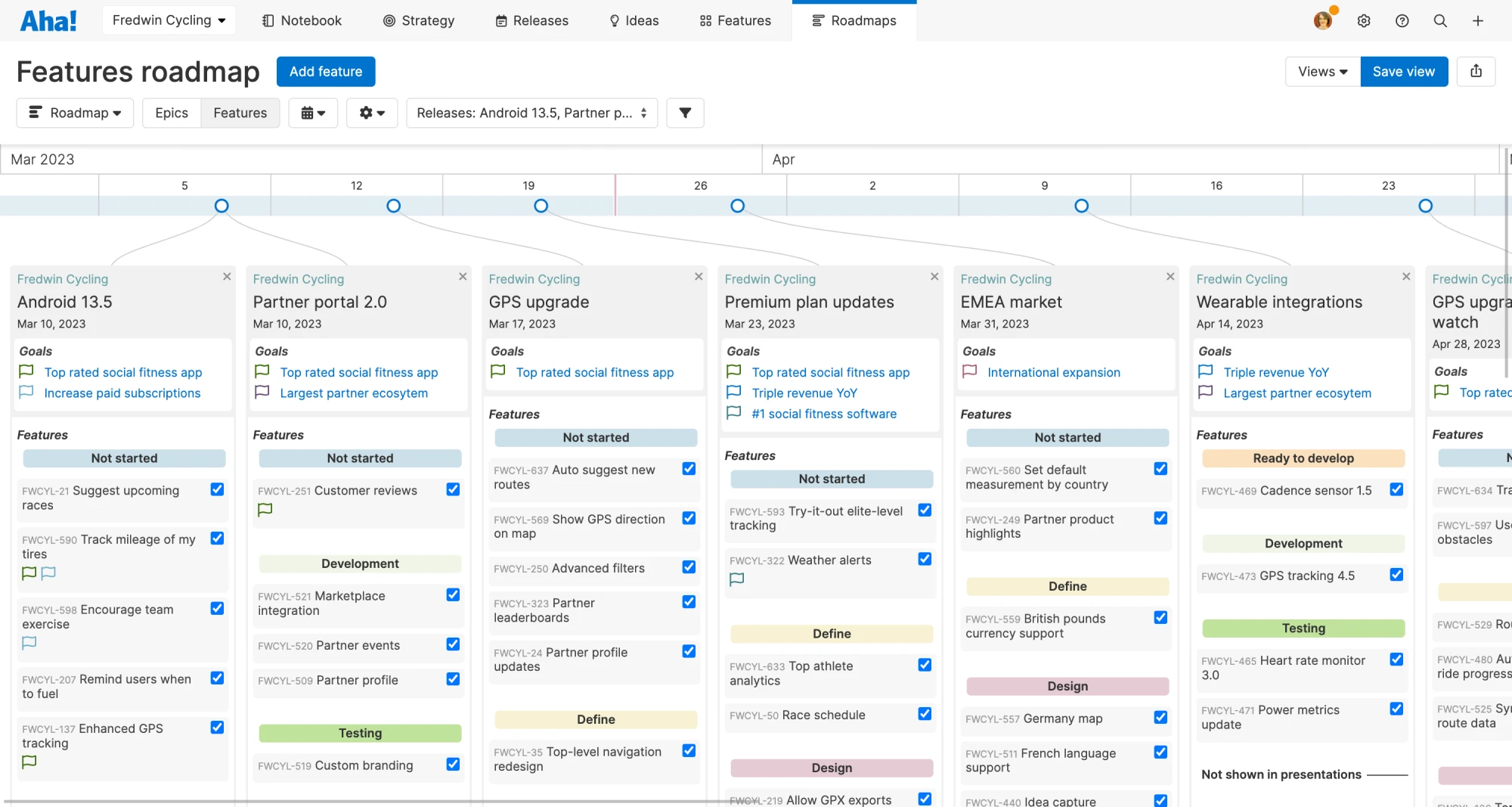
What is Aha!?
Aha! is one of the leading product management software solutions. So again, this app gives you at least one major advantage over airfocus — which just isn’t designed for the unique strategic needs and workflows of Product Managers.
But one common complaint you’ll hear and read repeatedly from Aha! users is that the app is complicated and difficult to configure. Be warned. As you can see from the screenshot here, Aha! creates a very loud and busy user experience.
Aha! pros:
- Designed for Product Managers and their teams.
- Includes flexible roadmapping views.
- Strong integrations with numerous apps.
Aha! cons:
- Offers only one built-in prioritization framework (compared to more than a dozen available with craft.io, for example).
- Doesn’t offer Excel-like functionality (to easily sort and order data sets by any column according to any criteria).
- Has a very busy and complicated UI, a common subject of user complaints on review sites.
- Quite expensive and not cost-effective for smaller teams.
Jira vs. airfocus

What is Jira?
Jira describes itself as “The #1 software development tool for agile teams,” and the key word in that description is development.
For years, Jira has been one of the leading applications engineers and software coders, helping these teams assign, monitor, and track their progress on tasks. And in recent years, Jira has made strides to expand its app to include some of the tools product management teams need as well.
But it’s important to remember that Jira was not designed for Product Managers. The app’s newer tools — such as product roadmapping functionality — are really only add-ons to the product’s core functionality and purpose, which is to help development teams stay aligned and moving forward on their tasks.
Jira pros:
- An invaluable integration into purpose-built product management software.
- Can help Product Managers directly monitor their dev teams’ progress on tasks.
- Includes product roadmapping capability.
Jira cons:
- Not designed to be product management software.
- Does not offer strategic-level planning or prioritization functionality.
Roadmunk vs. airfocus
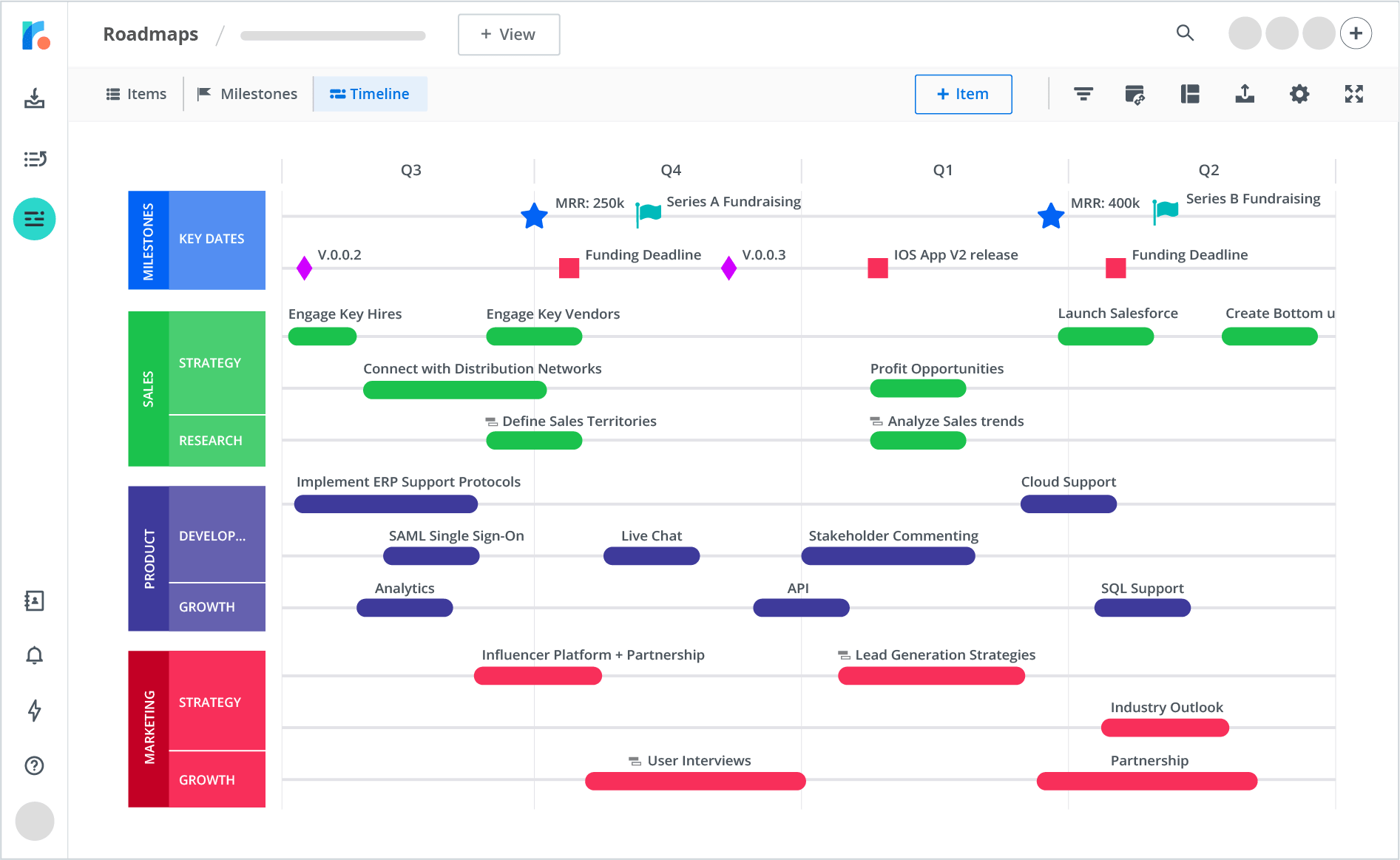
What is Roadmunk?
Roadmunk’s homepage describes the app as “The Top Agile Roadmapping Solution.”
So once again, we’ve found another point solution for Product Managers — in this case, an app designed just for roadmapping. And while that’s an important part of your workflow, you don’t want to build a product management software environment using numerous different apps.
Roadmunk pros:
- An excellent roadmapping interface.
- Two built-in prioritization templates to help you decide what to work on next.
Roadmunk cons:
- Not a complete product management solution (by far).
- No portfolio-level product management.
- No capacity planning.
- No Excel-like functionality (to easily sort and order data sets by any column according to any criteria).
- No built-in templates for persona development, user story or feature creation, etc.
Dragonboat vs. airfocus
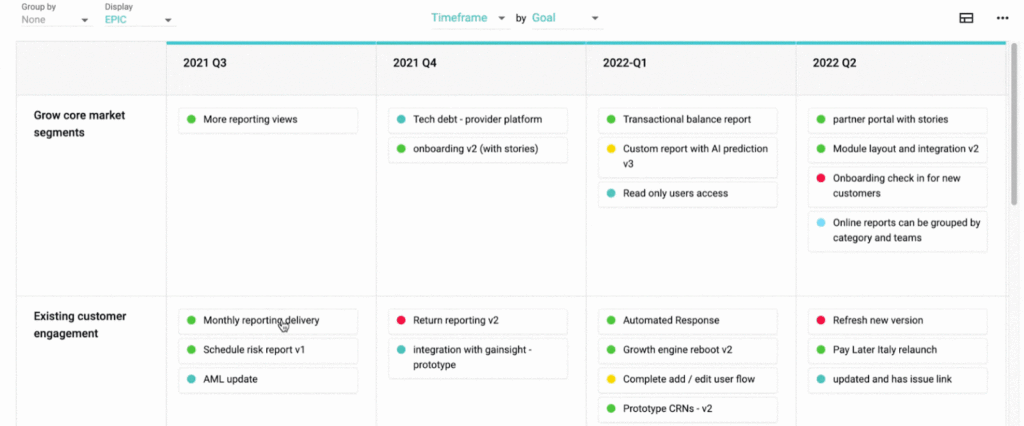
What is Dragonboat?
Dragonboat describes itself as a “product portfolio platform,” a software solution that helps product leaders more effectively manage their portfolio and business.
But like many of the other solutions we’re reviewing on this page, Dragonboat’s product management functionality is limited primarily to centralizing feature requests and roadmapping. If you want a complete product management solution, you’ll need Dragonboat and solutions for backlog management, feature definitions, persona and story creation, etc.
Dragonboat pros:
- Enables management at the product portfolio level. (Ideal for product leaders and product portfolio managers.)
- Centralizes and helps prioritize feature requests.
- Integrates with key apps such as Jira, Azure DevOps, and Slack.
Dragonboat cons:
- Not an end-to-end product management platform.
- Offers only a couple of built-in prioritization frameworks.
- No Excel-like functionality (to easily sort and order data sets by any column according to any criteria).
Monday.com vs. airfocus

What is Monday.com?
Of all the airfocus competitors we’re reviewing, Monday.com is one of the furthest away in terms of functionality and purpose. The company describes its app as a “Work OS” that lets teams create any workflow they want, including “Marketing, CRM, HR, software development, construction, video production, and so much more.”
In other words, this app is flexible but far from a purpose-built platform for Product Managers and their teams.
Monday.com pros:
- Great tool for creating workflows and cross-team collaboration.
- Ideal platform for project and task management.
Monday.com cons:
- Not a product management solution.
- Very few Product Manager-specific capabilities beyond a very basic roadmap view.
Clickup vs. airfocus
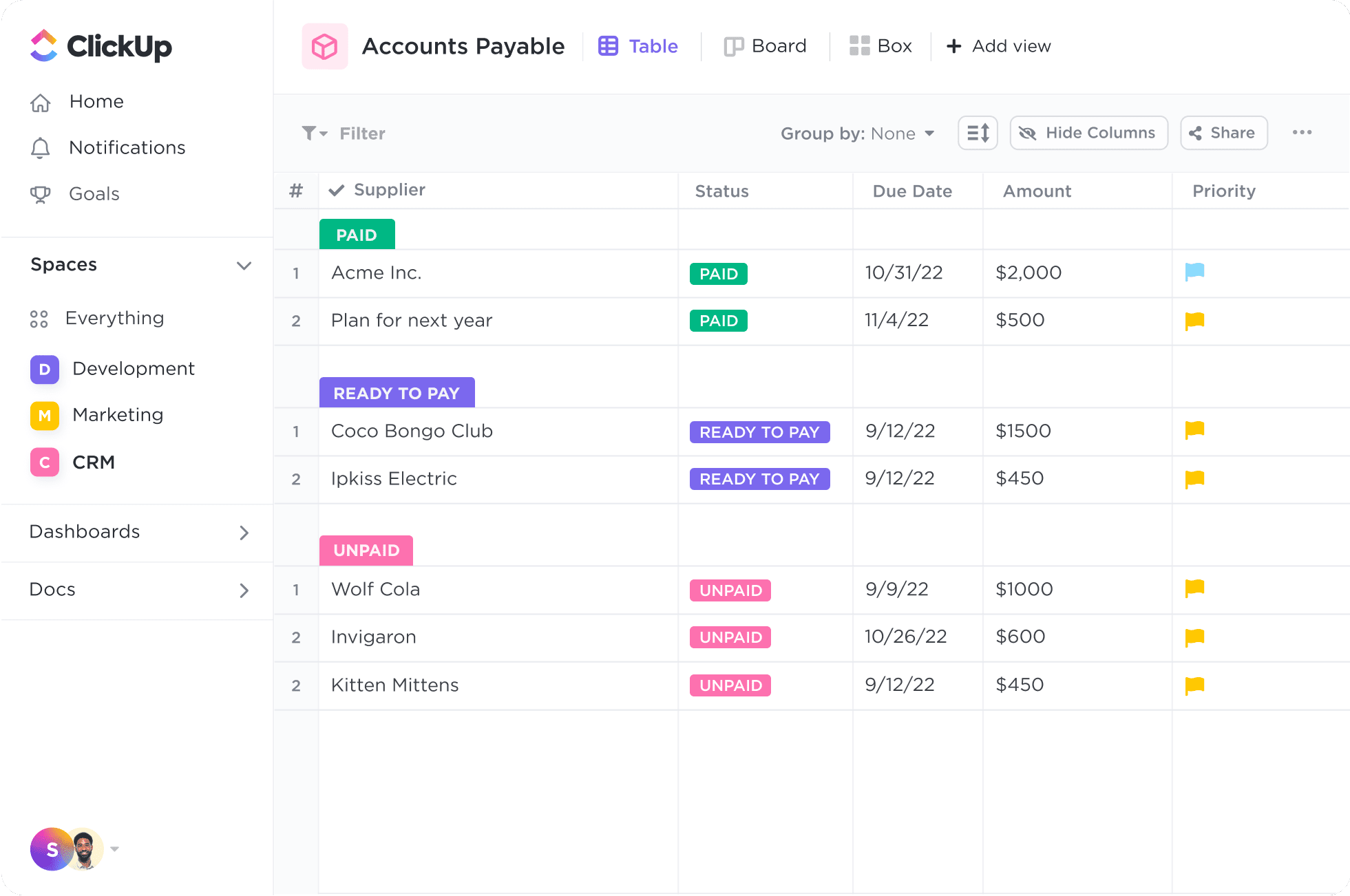
What is ClickUp?
Like Monday.com, ClickUp presents itself as a generalist software solution for better collaboration and more efficient workflows — but not specifically for Product Managers or their teams.
In fact, ClickUp’s homepage describes the solution as “One app to replace them all,” and then lists what the “them” includes: chat, tasks, whiteboards, goals, docs, dashboards. And while that sounds like a great solution for streamlining your colleagues’ workflows, it says nothing about how to make your Product Managers more effective at delivering successful products.
ClickUp pros:
- Excellent collaboration platform.
- Versatile digital environment that centralizes workflows and communications for teams across the company.
ClickUp cons:
- Not a product management solution.
- Very little product management functionality beyond basic roadmap creation.
Asana vs. airfocus

What is Asana?
Asana is another project management and collaboration platform. The company’s promise on the app’s homepage is to help you “Track, manage, and connect your projects across any team with Asana.”
And while Asana is a brilliant task management tool, it’s not designed specifically for product management departments or to meet the unique strategic workflows of Product Managers.
Asana pros:
- Excellent collaboration platform.
- Helps teams across a company assign and track tasks as well as manage long-term, complex initiatives.
Asana cons:
- Not a product management solution.
- Doesn’t include essential product management elements such as built-in prioritization frameworks.
ProdPad vs. airfocus
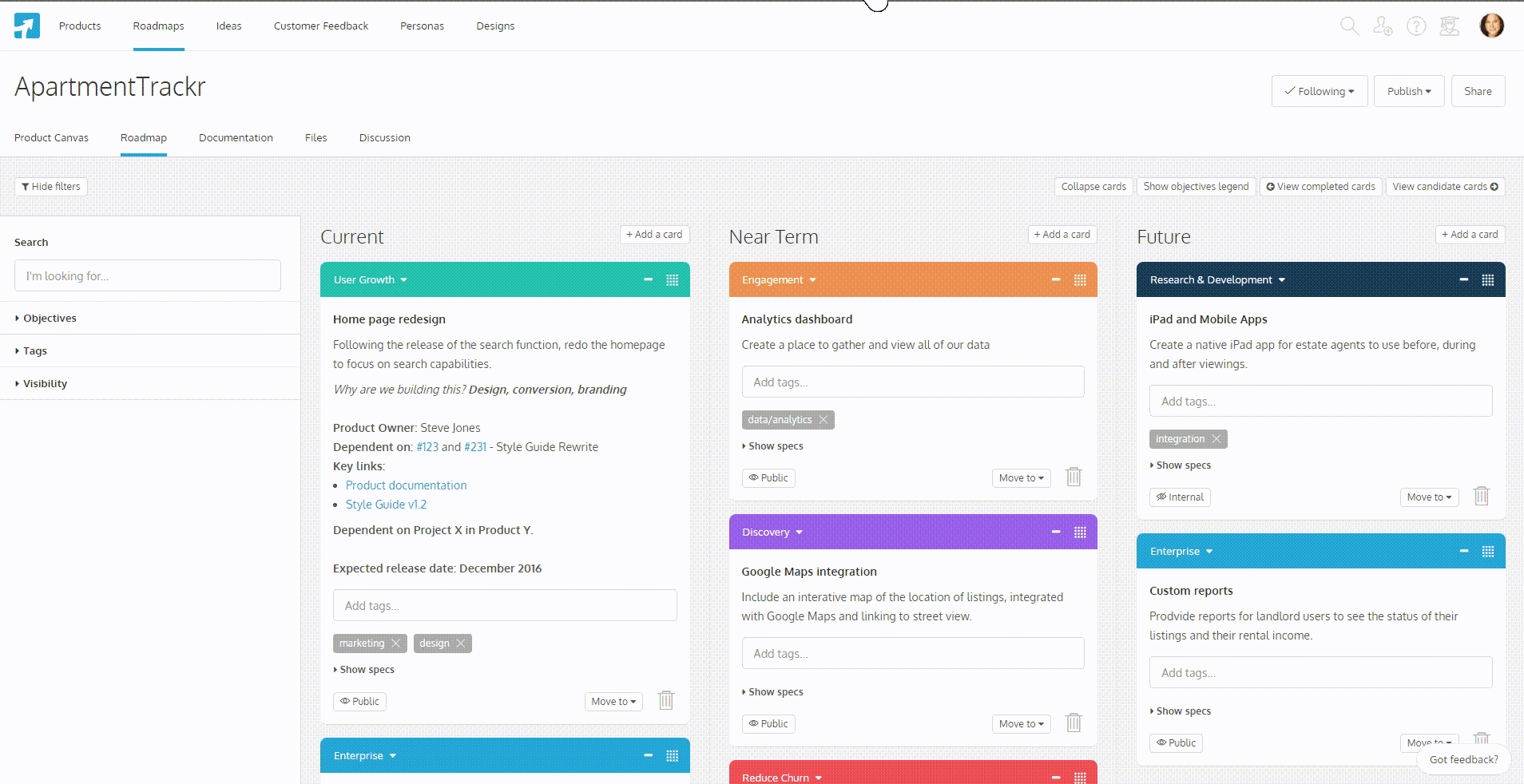
What is ProdPad?
ProdPad describes itself as a “product management platform.” So the company at least recognizes the importance of offering a solution designed specifically for Product Managers.
But the app itself doesn’t fully deliver on that promise. While ProdPad does offer more product management-specific functionality than some of the other apps we’ve discussed — for example, allowing users to roadmap and manage feedback in a central location — it falls far short of creating an end-to-end product management solution.
ProdPad pros:
- Enables product backlog management.
- Offers several roadmapping views.
- Lets teams connect roadmap items to OKRs.
ProdPad cons:
- Lacks built-in prioritization frameworks and requires a lot of manual inputs to score competing backlog items.
- No capacity planning.
- No Excel-like functionality (to easily sort and order data sets by any column according to any criteria).
- No product portfolio management capabilities.
- Offers only a very limited integration with Jira.
Canny vs. airfocus
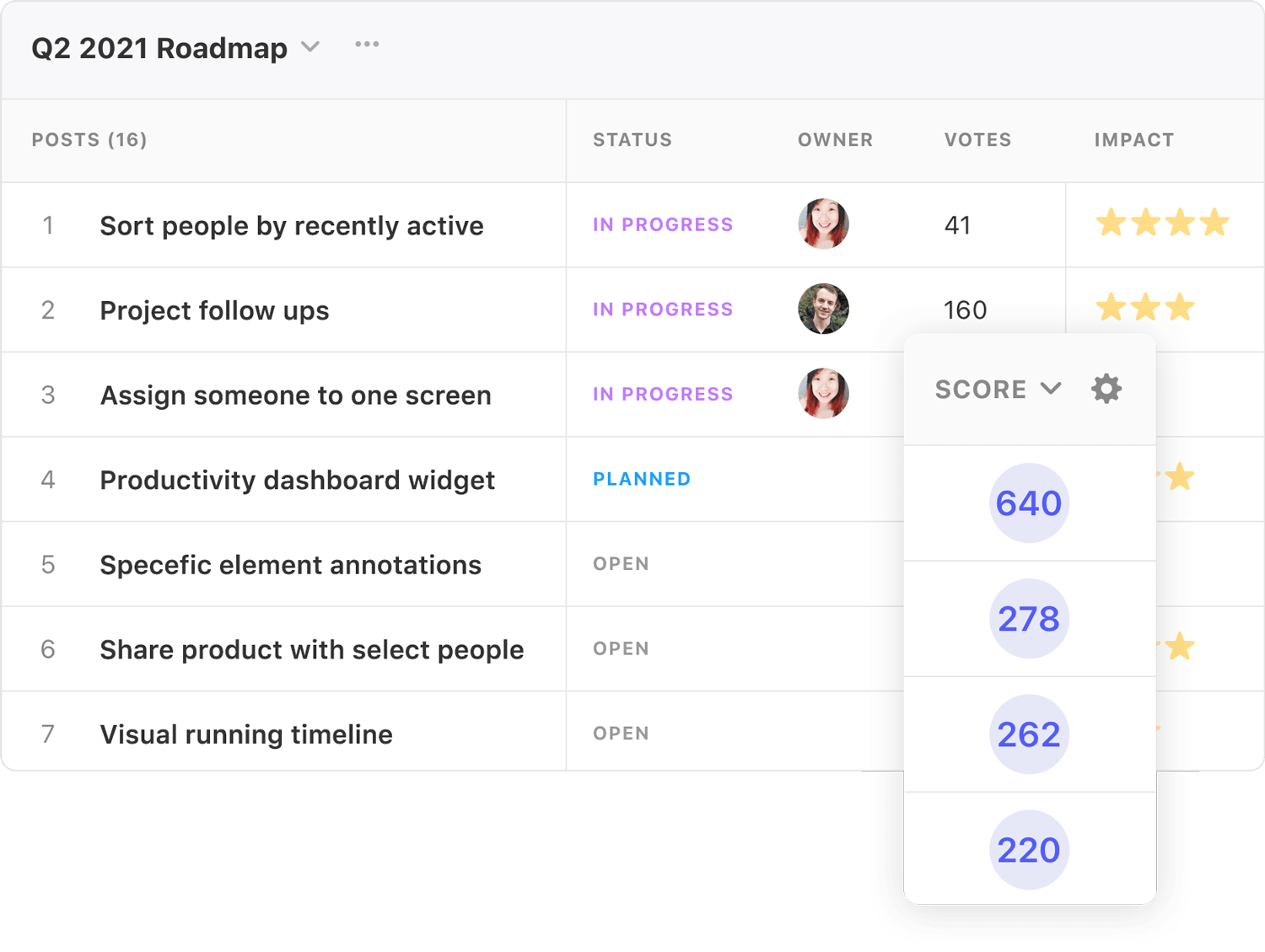
What is Canny?
On its homepage, Canny makes this promise to users:
“Capture, organize, and analyze product feedback in one place to inform your product decisions.”
So, in one sense, the company views its app as a tool for Product Managers. But in another important respect, this software is clearly a point solution at best — because it’s almost exclusively a feedback collection tool with a basic roadmapping feature bolted on.
In fact, to give you an idea of how incomplete many of these solutions are at creating a centralized environment for a product team’s strategic work, one of the featured business customers listed on Canny’s website… is ClickUp.
Canny pros:
- Powerful feedback collection and analysis tools.
- Allows teams to prioritize and clearly label work (“New,” “Improve,” “Fix,” etc.) based on feedback received.
- Helps to align teams across the company around a shared understanding of what users are saying about the products.
Canny cons:
- Not a complete product management platform.
- Offers very limited roadmapping functionality and flexibility.
- Does not include built-in prioritization frameworks, capacity planning, or other key product management capabilities.
Airtable vs. airfocus
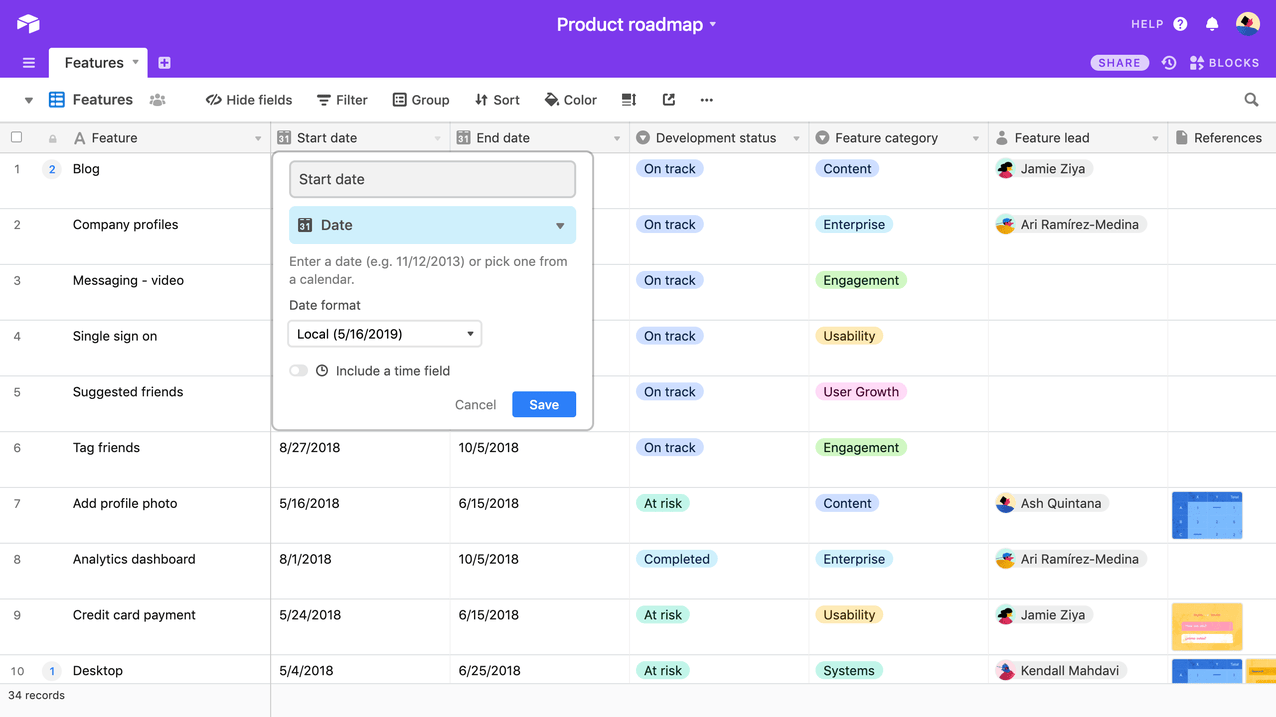
What is Airtable?
Airtable describes itself simply as “Everyone’s app platform.”
And once again, we’re looking at a business software platform that wants to do everything for all teams across the company. In Airtable’s case, this includes marketing, product, operations, human resources, sales, and finance.
Airtable does offer several important workflow tools for Product Managers — and we’ll list them below. But unfortunately, this is another app that supports only a small portion of a product team’s important strategic work, meaning it will force your team to spread the rest of your daily workflows to other software tools.
Airtable pros:
- Includes feedback collection capabilities.
- Allows users to create simple roadmaps (although using only a few visual formats).
- Lets users connect roadmap items to OKRs.
Airtable cons:
- Not a complete product management platform.
- No built-in prioritization frameworks. (Users are encouraged to “customize your own” scoring formulas.)
- Lacks capacity planning and resource-allocation capabilities.
Trello vs. airfocus
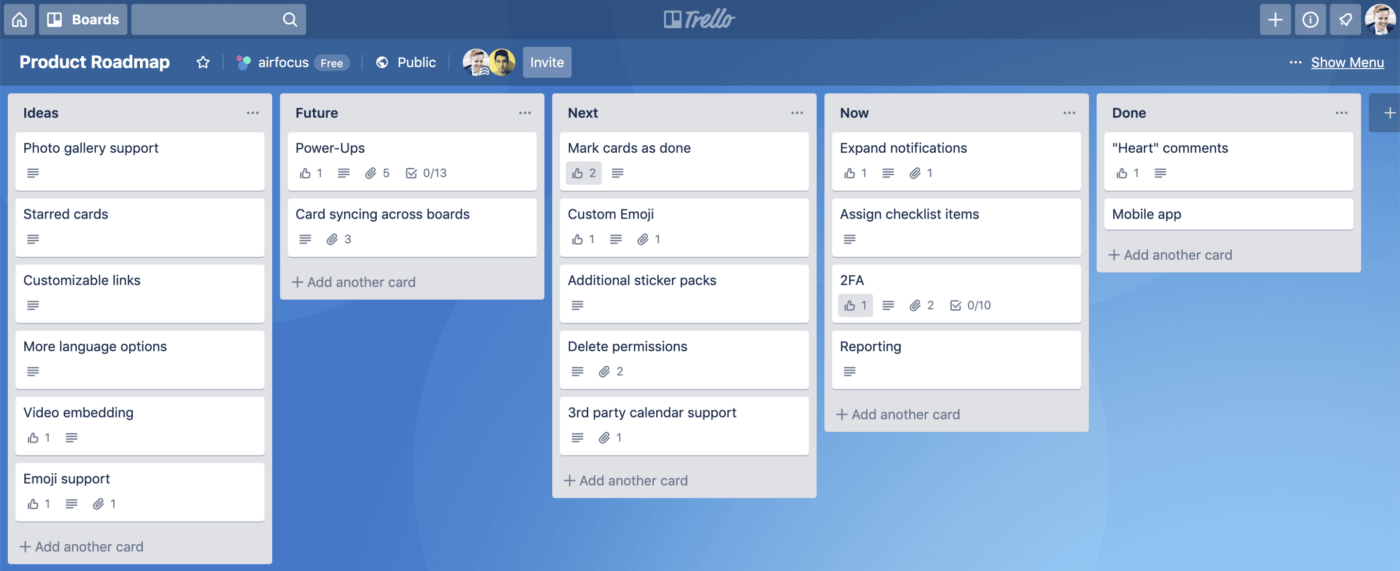
What is Trello?
As Trello’s parent company Atlassian explains on its website: “Trello is a collaboration tool that organizes your projects into boards.”
And on Trello’s own homepage, the four major use cases the app promises to help streamline include: project management, meetings, onboarding, and task management.
Just not product management.
Trello pros:
- Outstanding app for cross-team collaboration.
- Simplifies project management for complex company initiatives.
- Intuitive interface makes it easy to implement and use.
Trello cons:
- Not designed for product management.
- Offers only very basic roadmapping functionality with little flexibility in views or presentation modes.
- Does not include built-in prioritization frameworks, feedback collection, capacity planning, or other key strategic product management workflows.
Conclusion
As you can see from these reviews, airfocus is far from alone in missing the mark at creating an end-to-end platform for Product Managers and their teams. Building a solution that brings together all of the major components of a product team’s workflows — roadmapping, prioritization, capacity planning, portfolio management, etc. — into a single unified environment is a challenging task for a software company.
And that’s why most of the solutions we’ve discussed also fall short of offering a centralized product management environment. If you want to implement such a solution, rather than signing up for several different tools, check out our free Product Management Platform Buyer’s Guide.
In the meantime… try craft.io for free.

